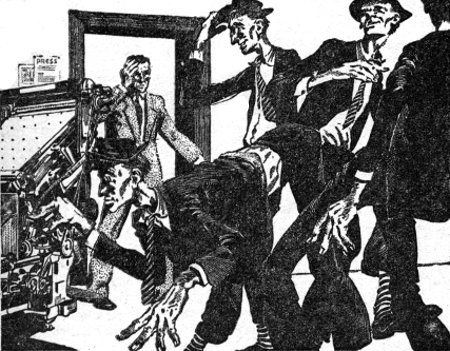
Nine Men In Time
By NOEL LOOMIS
[Transcriber note: This etext was produced Science Fiction Stories 1953.Extensive research did not uncover any evidence that the U.S. copyrighton this publication was renewed.]

The receivers, two of them lawyers, had long faces when they sat downacross from my desk in the office of the Imperial Printing Company.
"Frankly, Mr. Shane," said the older one, "it is a very grave questionin our minds whether we should try to continue to operate the businessor whether we should close the plant and liquidate the machinery andequipment the best we can."
I was stunned. "I don't understand," I said helplessly. "We've beendoing a nice business—and at a profit—in the year I've been here." Itwas my first big job, and I wanted to make good. I thought I had madegood, but here they were jerking the floor out from under me, and Icouldn't make any sense out of it.
"Well," said one, "the business isn't showing the profit we expected."
"What you need is a used-car lot," I said pointedly.
The elder man cleared his throat. "Now look, Mr. Shane, suppose we saythree months."
"What do you mean—three months?"
"We'll allow you to go ahead for three months. If the business doesn'tshow a distinct upturn by then—" He raised his eyebrows.
I swallowed hard. So that was it, then.
They even had the date set for the execution, and I knew they intendedto go through with it. Only a revolution would change that.
I wanted that job; it was my chance to make a name for myself. If theyshould close the plant now, I'd have a black eye. You can't go aroundasking for a job and saying, "But I was making money for them." They'llwonder what else was wrong.
I thought I knew why they were so willing to close the plant; it waspart of an estate, and the way things were, it took a lot of their timeeach month for not too big a fee. But if the estate should beliquidated—well, figure it out yourself. This business was all mixed upbetween an administratorship and a receivership, and the attorney's feesfor liquidation would be a percentage of a hundred-thousand-dollar shop.It could run to a nice sum. They'd sell out, collect their fee, andforget it. A nice clean deal for them. And no more worry.
That is what I was up against, so perhaps it was inevitable that Ishould find Dr. Hudson—Lawrence Edward Hudson. That was 1983, reallyabout the beginning of the scientific age in industry, and I dug thisidea up out of the back of my head where it had been for some time. Dr.Hudson was the result. I did not label him efficiency-expert, forprinters have always been notoriously allergic to that title. I calledhim production-engineer.
He was a small, thin-faced man with a face that seemed to all flow intoa point where his nose should have been, and he started talking thingsover with me before he got his coat off.
"Printing," he said, "is really the backward industry. There has beenno basic advance since the invention of the linecasting machine around1890, and possibly the development of offset printing."
"That," I said, "is why you are here—to bring out so